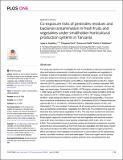| dc.identifier.citation | Kapeleka, J.A, Sauli, E, Sadik, O, Ndakidemi, P.A (2020)Co-exposure risks of pesticides residues and bacterial contamination in fresh fruits and vegetables under smallholder horticultural production systems in Tanzania.PLoSONE 15(7):e0235345.https://doi.org/10.1371/journal.pone.0235345 | |
| dc.description.abstract | This study was carried out to investigate the risks of simultaneous exposure to pesticide residues and bacteria contaminants in locally produced fresh vegetables and vegetables in
Tanzania. A total of 613 samples were analyzed for pesticide residues, out of which 250
were also analyzed for bacterial contamination. Overall, 47.5% had pesticide residues,
74.2% exceeded Maximum Residue Levels (MRLs). Organophosphorus (95.2%), organochlorines (24.0%), pyrethroids (17.3%), and carbamates (9.2%) residues dominated. MRL
values were mostly exceeded in tomatoes, onions, watermelons, cucumbers, Chinese cabbage, and sweet paper. Tetramethrin (0.0329–1.3733 mg/kg), pirimiphos-methyl (0.0003–
1.4093 mg/kg), permethrin (0.0009–2.4537 mg/kg), endosulfan (beta) (0.0008–2.3416 mg/
kg), carbaryl (0.0215–1.5068 mg/kg), profenofos (0.0176–2.1377 mg/kg), chlorpyrifos
(0.0004–1.2549 mg/kg) and dieldrin (0.0011–0.5271 mg/kg) exceeded MRLs. The prevalence of bacteria contamination was high (63.2%). Enterobacter (55.6%) Pseudomonas aeruginosa (32.4%), E. coli (28.2%), Citrobacter (26.8%), Klebsiella oxytoca (14.8%), and
Salmonella (7.7%) were isolated. Furthermore, 46.4% tested positive for both pesticide residues and bacterial contaminants. Vegetables from farms (60.7%) contained more dual contaminants than market-based vegetables (41.8%). This may have resulted from excessive
pesticide use and unhygienic handling of fresh fruits and vegetables at production level.
Binary logistic regression showed that fresh fruits and vegetables with pesticide residues
were 2.231 times more likely to have bacteria contaminants (OR: 2.231; 95% CI: 0.501,
8.802). The contamination levels of pesticide residues and bacterial contaminants could be
perceived as a serious problem as most fresh fruits and vegetables recorded values of pesticide residues far above the MRLs with pathogenic bacteria isolated in higher proportions.
MRLs was higher in most vegetables consumed raw or semi-cooked such as watermelons,
carrots, cucumber, tomatoes, onion and sweet paper. There is an urgent need to develop
pesticide monitoring and surveillance systems at farmer level, educating farmers and promoting the use of greener pesticides to mitigate the health effects of pesticides and bacterial contaminants. | en_US |

